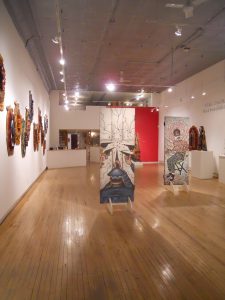
Intuit: Center for Intuitive and Outsider Art
If you have not seen a new blog posting for some time, it’s because I am in Chicago now, doing an internship at Intuit: The Center for Intuitive and Outsider Art.
If you are a Canadian reader, you know that there is no dialogue about outsider art in Canada. In fact, my motivation in starting this blog and entering graduate studies was to understand and document outsider art activities in Canada. I suffer from a lack of outsider art colleagues in Canada and I wanted to be in an environment where I was immersed in outsider art culture. So, a few emails later, the kind folks at Intuit in Chicago invited me to spend some time at their organization. I arrived one week ago.
Chicago is THE centre for outsider art in North America. Its roots go back as far as Jean Dubuffet’s post-war lecture in Chicago – Anticultural Positions – where he declared: “Personally I believe very much in values of savagery; I mean: instinct, passion, mood, violence, madness.” The private collections of outsider art in this city are enormous, or so I’ve heard. I am just on the brink of discovering them for myself. I hit the jackpot.
Intuit is a not-for-profit art centre. Not only do they exhibit outsider art, they are dedicated to educating the public
about it:
Established in 1991, Intuit: The Center for Intuitive and Outsider Art (Intuit) is the only nonprofit organization in the United States that is dedicated solely to presenting self-taught and outsider art — with world class exhibitions; resources for scholars and students; a Permanent Collection with holdings of more than 1,100 works of art; the Henry Darger Room Collection; the Robert A. Roth Study Center, a non-circulating collection with a primary focus in the fields of outsider and contemporary self-taught art; and educational programming for people of all interest levels and backgrounds.
The most interesting thing happened on my first day at Intuit. Two groups of Canadian tourists walked in to see the current exhibit. I was as surprised to meet them as they were to meet me. Then yesterday another Canadian visitor came in. The best news is that there are Canadians who are interested in exploring outsider art. Sadly, they have to come to the USA to find them. (That will all change once we get our act together. Right, Canada?)

One exhibit at Intuit is of Chicago artist, Eddie Harris. It is called It Takes a Hard Heart. Harris, 78, has been living in Chicago for nearly 50 years. His work reflects the black experience of living in the US. As a child, he picked cotton in Arkansas; as an adult he supported the Black Panther Party. His varied work of bas-relief wood carvings, carved and painted canes; paintings; pencil drawings; and community garden at his home speak to his belief in the inseparability of art, political activism and the search for beauty.

The other current exhibit is the work of Albert “Kid” Mertz (1905 – 1988) is called OHYOUKIDMERTZ. Mertz, once a prize-fighter and autoworker, lived in Michigan. When he retired, he started creating signs with off-beat sayings. The signs are painted on found material: cardboard, wood, shovels, old shoe soles… you get the idea. Some signs will make you laugh out loud and some will make you pause and think, yeah, he is so right.
Intuit also houses a recreation of Henry Darger’s one-room apartment in Chicago, where he lived for 40 years. His living and working space was crammed with paint, tracings, magazines, newspapers, comic books, children’s books, colouring books, broken eyeglasses, religious icons, fixtures, and balls of twine. It’s hard to know where to look first. The intention was to provide a window into Darger’s world. For those of you don’t yet know Darger’s work, it’s worth spending the time to explore his world. His 15,000 page story of the Vivian Girls, which his magnificent artwork illustrates, was written in this tiny, claustrophobic room.





